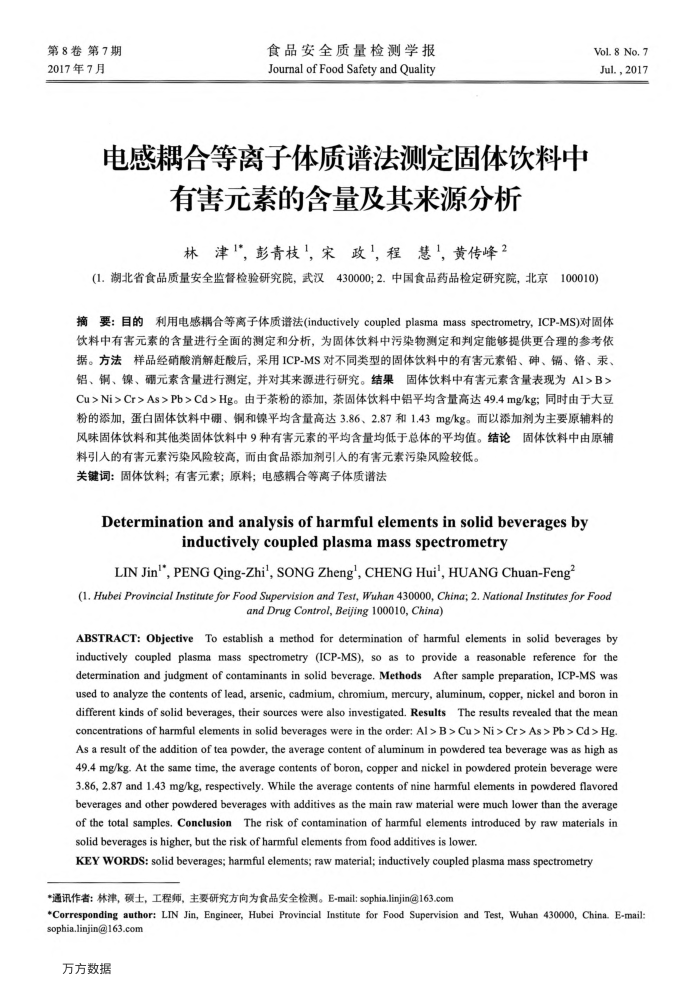电感耦合等离子体质谱法测定固体饮料中有害元素的含量及其来源分析
内容简介
 第8卷第7期 2017年7月
第8卷第7期 2017年7月食品安全质量检测学报 Journal ofFoodSafetyandQuality
电感耦合等离子体质谱法测定固体饮料中
有害元素的含量及其来源分析林津",彭青枝",宋政",程慧",黄传峰2
Vol.8 No. 7 Jul.,2017
(1.湖北省食品质量安全监督检验研究院,武汉430000;2.中国食品药品检定研究院,北京100010) 饮料中有害元素的含量进行全面的测定和分析,为固体饮料中污染物测定和判定能够提供更合理的参考依据。方法样品经硝酸消解赶酸后,采用ICP-MS对不同类型的固体饮料中的有害元素铅、碑、铺、铬、汞、铝、铜、镍、硼元素含量进行测定,并对其来源进行研究。结果固体饮料中有害元素含量表现为A1>B> Cu>Ni>Cr>As>Pb>Cd>Hg。由于茶粉的添加,茶固体饮料中铝平均含量高达49.4mg/kg;同时由于大豆粉的添加,蛋白固体饮料中硼、铜和镍平均含量高达3.86、2.87和1.43mg/kg。而以添加剂为主要原辅料的风味固体饮料和其他类固体饮料中9种有害元素的平均含量均低于总体的平均值。结论固体饮料中由原辅
料引人的有害元素污染风险较高,而由食品添加剂引人的有害元索污染风险较低。关键词:固体饮料;有害元素;原料;电感耦合等离子体质谱法
Determinationand analysis of harmful elements in solidbeverages by
inductivelycoupledplasmamassspectrometry
LIN Jin"",PENG Qing-Zhi', SONG Zheng',CHENG Hui',HUANG Chuan-Feng
(1. Hubei Provincial Institute for Food Supervision and Test, Wuhan 430000, China; 2. National Institutes for Food
and Drug Control, Bejing100010, China)
ABSTRACT: Objective To establish a method for determination of harmful elements in solid beverages by aeeaa determination and judgment of contaminants in solid beverage. Methods After sample preparation, ICP-MS was used to analyze the contents of lead, arsenic, cadmium, chromium, mercury, aluminum, copper, nickel and boron in different kinds of solid beverages, their sources were also investigated. ResultsThe results revealed that the mean concentrations of harmful elements in solid beverages were in the order: Al > B > Cu> Ni > Cr> As > Pb > Cd > Hg. As a result of the addition of tea powder, the average content of aluminum in powdered tea beverage was as high as 49.4 mg/kg. At the same time, the average contents of boron, copper and nickel in powdered protein beverage were 3.86, 2.87 and 1.43 mg/kg, respectively. While the average contents of nine harmful elements in powdered flavored beverages and other powdered beverages with additives as the main raw material were much lower than the average of the total samples. ConclusionThe risk of contamination of harmful elements introduced by raw materials in solid beverages is higher, but the risk of harmful elements from food additives is lower.
KEY WORDS: solid beverages; harmful elements; raw material; inductively coupled plasma mass spectrometry*通讯作者:林津,硕士,工程师,主要研究方向为食品安全检测。E-mail:sophia.linjin@163.com
*Corresponding author: LIN Jin, Engineer, Hubei Provincial Institute for Food Supervision and Test, Wuhan 430000, China. E-mail
sophia.linjin@163.com 万方数据
上一章:植物源提取物对金黄色葡萄球菌的抗菌作用
下一章:共轭亚油酸生理功能研究进展
相关文章
电感耦合等离子体质谱法测定葡萄酒中32种元素的含量
SJ/T 11555-2015 用电感耦合等离子体质谱法测定硝酸中金属元素的含量
YS/T 870-2020 纯铝化学分析方法 痕量杂质元素含量的测定 电感耦合等离子体质谱法
GB/T 38789-2020 口腔清洁护理用品牙膏中10种元素含量的测定电感耦合等离子体质谱法
GB/T 38789-2020 口腔清洁护理用品 牙膏中10种元素含量的测定 电感耦合等离子体质谱法
HJ 766-2015 固体废物 金属元素的测定 电感耦合等离子体质谱法
NY/T 4313-2023 沼液中砷、镉、铅、铬、铜、锌元素含量的测定 微波消解-电感耦合等离子体质谱法
DZ/T 0398-2022 磷矿石化学分析方法 稀土元素含量的测定 混酸分解—电感耦合等离子体质谱法